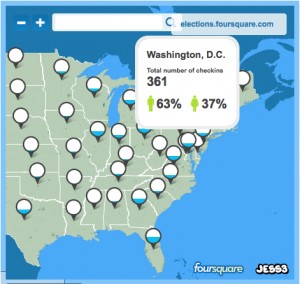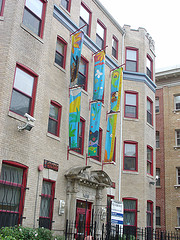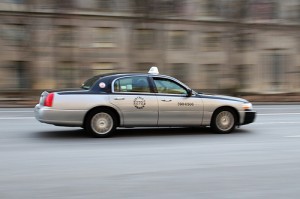November 2, 2010 | 4:52 PM | By Anna

Hillicon Valley
This is neat. According to Hillicon Valley, a popular location-based social network is getting in the spirit of Election Day:
FourSquare, an application that allows people to broadcast their whereabouts to their friends, doles out an “I voted” badge to users who “check in” with the site when they arrive at their voting place.
But, wait! There’s more!
…swing by elections.foursquare.com to watch America vote in real-time throughout the day, with all the check-in data from polling stations across the country. Navigate the map to see where foursquare voter turnout is happening, and all the details about how and where our country performs its civic duty. [4sq]
That’s a screenshot of how many D.C.-users have checked in (plus what gender they are). Some may ask why badges or “checking in” to polling places matters for Election Day; considering how Foursquare tends to alter its users behavior, I think it’s significant. Foursquare power-users are motivated to play the game constantly– and now they’ve been given a special incentive to get out the vote.
November 2, 2010 | 1:15 PM | By Anna

Elizabeth Thomsen
Precinct 36: Latin American Youth Center, 1419 Columbia Road, NW
Just wandered down to my local polling place and heard that out of 5,333 registered voters, a total of 505 have participated in the democratic process.
There were no lines, and it was fairly quiet, which makes sense because it’s after lunch. This morning it was busy and they’re expecting traffic to pick up again at 4pm, when the apres-work crowd arrives.
If you don’t know where your polling place is, DC’s BOEE has a very useful site which asks for your address and then tells you where to go. You have until 8pm tonight, to vote.
October 5, 2010 | 12:45 PM | By Anna
Just finished reading Mike DeBonis’ column, “Consultant’s postmortem: Fenty became ‘flawed and expendable’”:
Bill Knapp — the veteran political communications consultant, whose business partner Anita Dunn consulted for both Fenty and Schools Chancellor Michelle Rhee — has come forward to explain to Democratic operatives that this was more about Fenty’s preternaturally bad communications instinct than a latent anti-incumbent mood…
Fenty lost, Knapp writes, because he “neglected a critical base” and “symbolic of that was the Sunday before the election when he participated in a triathlon in DC instead of visiting African American churches, as his opponent did.”
Ugh. That’s brutal. Triathlons are impressive, but he needed to focus on some church-going folks at that point, not his fitness. Continue reading →
September 24, 2010 | 12:14 PM | By Anna
How you voted, via Mike DeBonis at WaPo:
Black turnout went up. It wasn’t just gentrifying areas where turnout rose. In Ward 8, with the highest proportion of African Americans, the number of ballots cast rose 27 percent, and 82 percent of them were for Gray. In Precinct 107, in Ward 7′s Greenway neighborhood, 148 more voters showed up this year than in 2006 – a 46 percent jump. In the wards Fenty won (1, 2, 3 and 6), there were about 9,400 more votes than in 2006. But in the wards Gray won (4, 5, 7 and 8), turnout rose by more than 6,800. Fenty-friendly areas might be growing fast but not nearly fast enough to help him: There were 7,800 more votes in Gray’s wards than in Fenty’s. The city might be changing, but one still cannot win by the white vote alone.
Where Fenty lost. The story of this election can be found in the city’s largest precinct: Precinct 66, voting at Bertie Backus Middle School in Ward 5, next to the Fort Totten Metro station. It’s in the heart of middle-class black Washington; according to 2000 Census figures, the precinct is 96 percent black and the homeownership rate is 75 percent, well above the city average. It’s also the only precinct in the city that saw more than 2,000 votes, and 79 percent of them went to Gray. Gray emerged from 66 with a 1,287 vote lead – more than one-tenth of his total victory margin. Backus, incidentally, was among the 23 public schools Fenty closed in 2008.
I’ll admit, my eyes tend to glaze over when I see that many numbers encased in a paragraph, but I couldn’t stop reading– and learning and confirming.
September 23, 2010 | 3:35 PM | By Anna

Soulfull
Today, we’re full of love for the City Paper. Right now we’re reading the “Loose Lips” column, where we found the following regarding Marion Barry:
“To the victor go the spoils,” Barry tells LL. “We demand more than our fair share because we’ve been neglected for so long, it’s as simple as that.”
Sigh. That’s the sound Almost Mayor Vincent Gray just made when he read that line—because if Gray is going to be successful as leader of his “One City,” he’ll have to convince white residents (especially in neighborhoods west of Rock Creek Park that voted for Adrian Fenty last week) that he’s not a rampaging Visigoth who wants to take their new breadmakers and Subarus and give them away to families living east of the Anacostia River.
Why not an Ostrogoth? Did they not rampage? I kid. Continue reading →
September 17, 2010 | 1:20 PM | By Anna
Remember that incendiary Milloy column? Borderstan gets it:
Yes, I guess Milloy was referring to this area of the city, to Logan Circle and U Street and the 14th Street corridor. We are, I suppose, the stereotype, of all things suspicious to Milloy. We have dog parks (two of them) and we have bike lanes (lots of them). “Chic eateries” and users of “social networks” abound…
On Tuesday, we collectively did as he suspects: Voters in precincts here gave Fenty 70 to 80% of the vote. But, while we supported him here, I don’t think you’d find many people here who would disagree that Fenty was the cause of many of his own problems….
None of this is meant to downplay the serious problems facing Washingtonians in other parts of the city, too many of them in dire economic circumstances. But wishing these newcomers would go away will do nothing to solve the horribly high rates of unemployment in DC.
I would also suggest—strongly—that many of my new neighbors make an effort to understand DC’s history. Only by doing so can you understand Milloy’s column and the frustrations he expressed.
September 16, 2010 | 3:59 PM | By Anna
The Atlantic’s Ta-Nehisi Coates on Adrian Fenty:
A lot has been made of the role of race in this campaign, and the sense that Fenty is the tool of white interlopers seeking to turn D.C. into Seattle. Fear of the oncoming white horde of gentrifiers is old in D.C. and I do not doubt that the paranoia was an integral part of the political landscape. But having understood that landscape, it’s a politician job to navigate it.
…The business is politics, not debate club.
It is not enough to simply be right, if only because sometimes you aren’t.
September 16, 2010 | 10:21 AM | By Anna
Quick follow-up about Maryland Delegate Saqib Ali, whom we posted about last week after his opponent, State Senator Nancy King sent out campaign mail which featured an altered image of him with a darker complexion; he lost by 227 votes.
“We fought the best race we possibly could,” Ali said. “We spent nearly a quarter million dollars, knocked on thousands of doors. We tried to concentrate on the issues.”
Ali said King’s negative campaign mailers – one of which featured a photo of Ali with darkened skin – did not help her gain ground with voters…
Ali, whose term as delegate ends in January, would not comment on his future in politics. “I’m going to go home, take a nap, rest and see what tomorrow brings,” he said. “We’re going to hold our heads high.”
September 15, 2010 | 2:43 PM | By Anna
We usually serve links in the morning, but after yesterday’s historic primary, we’d be remiss if we didn’t round up the best post-mortems we’ve seen. Today, all anyone can talk about is, “What happened to Adrian Fenty?” The five features below have answers. The first article, from the Washington Post, is excellent– if you can only read one, that’s my pick.
How Adrian Fenty lost his reelection bid for D.C. mayor “…the story of a mayor who misread an electorate he was sure he knew better than anyone, who ignored advisers’ early warnings that key constituencies were abandoning him, who shut out confidantes who told him what he did not want to hear and who began to listen only when the race was all but lost.” (The Washington Post)
Adrian Fenty loses D.C. mayoral primary: Why his re-election bid failed “The price that Fenty was paying for all of those recreation centers, for all of the ribbon-cuttings, for all of the education initiatives, was the most powerful block of voters in town.No one could argue that he’d neglected black neighborhoods, but in the end, that was almost the point: Black neighborhoods, in many instances, didn’t want to see the brand of change Fenty was providing. Asked about the sparkling Deanwood Recreation Center, a Ward 7 resident quoted in the Washington Examiner said, “Fenty is getting ready for white people moving into the community.”" (tbd.com)
Post-Election Analysis: It’s Not The End of The District “Finally, reform just doesn’t turn back on itself, as Fenty tried to say it would. Over the last 12 years, each mayor has left a foundation upon which his successor has built. We can all marvel at what Fenty has done in four years, but not much of it would have been possible without Mayor Anthony Williams. Gray will enter office in uncertain economic times — but also with many of the toughest decisions already made for him. Reforms gain momentum and evolve — and even if he wanted to, Gray wouldn’t simply be able to stop the city and throw it into reverse. ” (DCist) Continue reading →
September 15, 2010 | 10:16 AM | By Anna

Mr. T in DC
A district taxicab.
The Washington Post has an interesting article about one group of Gray supporters and how they pitched in yesterday: cabdrivers.
The city’s roughly 6,000 taxi cabdrivers, a group made up largely of African-born immigrants, have long been upset with Mayor Adrian M. Fenty (D) over his 2007 change from the city’s zone fare system to meters. On Tuesday, they waged what one union leader called “the fight for our very lives.”
I take cabs frequently and I can vouch for this; by this summer, drivers were inquiring about for whom I’d vote and asking if I’d like more information about their take on the race. When I discovered that many of them didn’t live in the district and thus, couldn’t vote themselves, they’d only get more vocal about their inability to do so– and my need to be educated before I cast my ballot.
While the article examines the dynamic of African immigrants focusing their ire on an African American mayor, I met several African-American cabbies who had been born and raised in D.C., who had lived in this city for six or seven decades, and they were passionately disappointed with Fenty, too. Continue reading →






